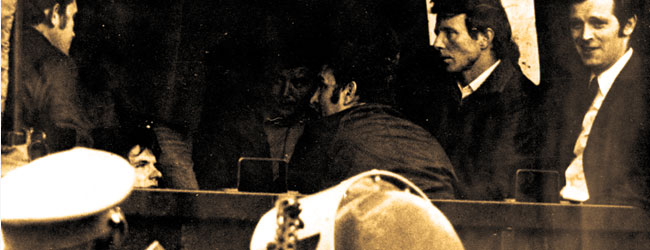18 August 2011
Internment without trial
‘Armoured cars and tanks and guns came to take away our sons’ — From the song ‘The Men Behind the Wire’
BY MÍCHEÁL Mac DONNCHA
NO single decision by the British Government in Ireland did more to violate human rights and to escalate the conflict than the decision to impose internment without trial in the Six Counties. Detention without charge was in force between August 1971 and December 1975 and during that time nearly 2,000 people were interned.
The significance of internment was somewhat over-shadowed in later years as people recalled the Bloody Sunday massacre in January 1972 and the long prison struggle and hunger strikes in the H-Blocks and Armagh Jail
In the early hours of Tuesday 9th August 1971, the British Army raided homes across the Six Counties:-
» 342 of the 450 men on the list were arrested;
» 116 were released within 48 hours;
» 226 were detained: 86 from Belfast, 60 from County Derry, 20 from Newry, 20 from Armagh and 40 from Tyrone and Fermanagh.
The raids were accompanied by widespread British Army brutality, assaults on people, wrecking of homes and many shootings.
In Ballymurphy, the Parachute Regiment shot dead 11 innocent civilians in the three days after internment was imposed.
A number of those arrested in the initial and subsequent internment swoops were subjected to torture in interrogation centres in British Army barracks.
Techniques included blindfolding and throwing from helicopters prisoners who believed they were hundreds of feet in the air, making prisoners run barefoot over broken glass, ‘white noise’ and other ‘sensory deprivation’ methods, forcing prisoners to stand for hours spreadeagled against a wall and straightforward beatings.
The European Commission of Human Rights ruled in 1976 that the British authorities were guilty of torture and inhuman and degrading treatment.
A week after the initial swoop, Joe Cahill of the Belfast IRA appeared at a press conference in Belfast and revealed that fewer than 30 of those interned were Volunteers and that the IRA’s capacity to operate was undamaged.
A strong feature of the first six months of internment was the large number arrested and then released. Up to February 1972, over 2,300 were arrested under the Special Powers Act and 598 were interned. Arrest solely for the purpose of interrogation was widespread.
Internees were held initially in ‘C’ Wing of Crumlin Road Prison and on the Maidstone prison ship docked in Belfast Harbour. But the main place of detention was to be an airfield just south of Lisburn used by the RAF during the Second World War and a British Army vehicle park since then. This was Long Kesh.
Long Kesh internment camp, by May 1972, consisted of ten ‘cages’. These were 12-foot-high wire fences topped with barbed wire and enclosing four Nissen huts and a washroom. Three huts were for sleeping and one for a canteen. There were 40 men to a hut in grossly over-crowded, poorly heated and unsanitary conditions.
A small number of women were interned in Armagh Prison, the first being Liz McKee, aged 19 who was interned on New Year’s Day 1973.
There were 1,981 people interned without trial in the Six Counties between 9th August 1971 and 5th December 1975, when internment was formally ended. Of this total, only 107 were loyalists.
Follow us on Facebook
An Phoblacht on Twitter
Uncomfortable Conversations

An initiative for dialogue
for reconciliation
— — — — — — —
Contributions from key figures in the churches, academia and wider civic society as well as senior republican figures





